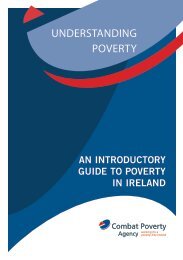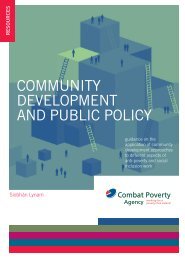Evaluating Integrated Responses to Educational Disadvantage (2000)
Evaluating Integrated Responses to Educational Disadvantage (2000)
Evaluating Integrated Responses to Educational Disadvantage (2000)
- No tags were found...
Create successful ePaper yourself
Turn your PDF publications into a flip-book with our unique Google optimized e-Paper software.
SECTION 2BACKGROUND AND PROGRAMME OUTLINEEarly school-leaving can be unders<strong>to</strong>od as young people leaving school before the legal school-leaving ageand/or leaving school without formal, or with limited, qualifications.Concern with early school-leaving as a social and political issue emerged during the 1980s, mainly as a resul<strong>to</strong>f the fall in the number of unskilled and semi-skilled manual jobs available for those who left formaleducation early or relatively unqualified. This concern became focused on the issue of youth unemploymentand in areas, particularly urban areas, where participation in post-compulsory schooling was low and theyouth populations was high, the issue was seen as a social, community problem.The numbers of young people at risk of early school-leaving are also cause for concern. The 1997 School-Leavers' Report estimated that, out of almost 70,000 second-level school-leavers, 2,200 young people leftwith no qualification 4 . A further 10,000 students left school with only limited qualification, i.e. with no morethan five passes in their Leaving Certificate. The report had no estimate for the number of children who didnot transfer from primary <strong>to</strong> secondary levels.Initially, official responses <strong>to</strong> the problem of early school-leaving were mainly channelled through programmesprovided by community/voluntary agencies with the help of government and European Union (EU) funds. Ata national level, a youth employment levy was introduced and a government Social Guarantee made acommitment <strong>to</strong> provide early school-leavers with places on school-work transition programmes in the form ofpre-vocational training, formal skills training and work experience. This official response viewed early schoolleavingas a loss of human capital, and it focused on post-education interventions.Human CapitalThe education as human capital approach emphasises the role of education in dealing with skills shortages andchanging technological needs. This reflects a trend of governments <strong>to</strong> perceive their investment in educationas an investment in the national s<strong>to</strong>ck of human capital thereby increasing competitiveness within globalmarkets. Improvements in education, brought about through school-retention and better literacy abilities,increases productivity within knowledge-driven international markets. This approach continues <strong>to</strong> influencepolicy and is currently evident in the Irish government's National Development Plan, <strong>2000</strong> - 2006 s .Integrative <strong>Responses</strong>As early school-leaving emerged as a social problem, alternative analyses <strong>to</strong> those simply based on loss ofhuman capital and economic efficiency developed. The integrative approach defines early school-leaving asreflecting multiple levels of detachment from the social, economic and cultural mainstream. This analysis isconsistent with social inclusion policies that have become common in both EU and national programmes.Social inclusion policies emphasise the need for stronger associative relationships directly linking people <strong>to</strong>mainstream economic, social, cultural and educational structures. Ideas around "participations", "integration"and "empowerment" are underlined in such policies. The Demonstration Programme is based on thisparticular analysis.Development of ProgrammeDuring the early-<strong>to</strong> mid-1990s, the Combat Poverty Agency had been <strong>to</strong> the fore among government bodiesin promoting social inclusion policies. The Agency became increasingly aware of the research evidence linkingpoverty with long-term unemployment and linking educational differences with labour market differentials. 6Amid growing concerns about the rising numbers of unqualified school-leavers, the Agency involved itselfwith the issue of educational disadvantage. However, by the mid-1990s, the Agency had not yet launchedany significant, meaningful research or practical actions on educational disadvantage. In 1995, an importantreview of policy measures for tackling educational disadvantage was initiated in conjunction with theDepartment of Education 7 .In 1994, the Agency had been requested by the Minister of State at the Department of Social Welfare <strong>to</strong> setup and administer a department fund for tackling early school-leaving. While the Agency was cautious aboutbecoming involved with funding educational actions - which might be considered a legal function of theDepartment of Education and Science - it believed that the fund might help it <strong>to</strong> assess the type and numberof practical initiatives already taking place and <strong>to</strong> improve its own capacity on the issue. The Agency decided<strong>to</strong> use the fund as a once-off, time-limited grants scheme <strong>to</strong> support and evaluate 14 localised actions aimedat tackling early school-leaving.An advisory group drawn from representatives from national youth organisations, the Department ofEducation and Science, Youthreach and the Economic and Social Research Institute helped the Agency <strong>to</strong>assess the fund's evaluation and <strong>to</strong> develop proposals for a follow-up programme. The group concluded tha<strong>to</strong>nce-off, dispersed actions had very little effect on educational issues, generally. There was growing frustrationamong those schools and youth and community organisations that had already initiated and developed pilotactions but could see no evidence of these being adapted nationally.The Combat Poverty Agency had been involved with other pilot programmes where scaling-up had beenachieved, particularly the Community Development Programme and the Local Development Programme. TheAgency was conscious of the critical role played by community development approaches in both theseprogrammes and other similar programmes with which it was involved. It was committed <strong>to</strong> ensuring thatany new programme it sponsored would have a community development focus also. The Agency envisagedthat, through an integrated approach, community groups could develop a more effective role in tacklingeducational disadvantage, in conjunction with schools and other local bodies.Community Development FocusIn its overall approach, the Combat Poverty Agency adopted a community development perspective <strong>to</strong>developing responses <strong>to</strong> educational disadvantage. It recognised that the central arena for planning,developing and taking action need not be either school-based or school-determined. The Agency emphasisedthat the causes of educational disadvantage lay in the "discontinuity between the school and the non-schoolexperiences of disadvantaged children" and that interventions needed <strong>to</strong> go beyond "conventionalschooling". 8 The approach emphasised the value of achieving more effective home-school-communitylinkages where each is assigned equality of status. These linkages could develop either in or outside schoolsettings and they could focus on any (or many) of a number of issues, interventions or development ofrelationships.To facilitate an appropriate integrated response, in the context of the Demonstration Programme, the Agencyadvocated basing this on local networks that would consist "of all relevant parties engaged in educationprovision, broadly defined, in the area". Such networks typically would consist of:•Collins, C. Williams. |. (1998). The 1997 Annual School-Leavers' Report: Results of the School-Leaven'Surveys, 1995-1997,Dublin: Department of Enterprise Trade and Employment. Department of Education and Science, and ESRI.Government of Ireland (<strong>2000</strong>). Ireland Notional Development Plan, <strong>2000</strong>-2006, Dublin: The Stationery Office.<strong>Evaluating</strong> <strong>Integrated</strong> <strong>Responses</strong> Jm>'Breen, R. (1991), Education, Employment and Training in the Youth Labour Market, Dublin: Economic and Social Research InstituteKellaghan, T, Weir, S., 6'hUallachain, Morgan, M (1995), <strong>Educational</strong> <strong>Disadvantage</strong> in Irelond, Dublin. Department ol Education, CombatPoverty Agency and the <strong>Educational</strong> Research Centre." See footnote 3( <strong>Evaluating</strong> <strong>Integrated</strong> <strong>Responses</strong> ^^TT^













